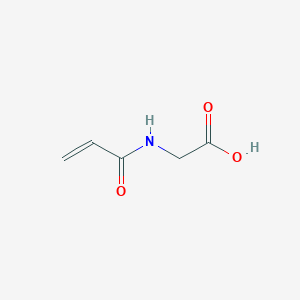| General Information of MET (ID: META00450) |
| Name |
N-Acryloylglycine
|
| Synonyms |
Click to Show/Hide Synonyms of This Metabolite
1-Aminopropenal acetic acid; 2-[(1-Hydroxyprop-2-en-1-ylidene)amino]acetate; APAA; N-(1-oxo-2-Propenyl)-glycine; N-Acryloyl-glycine
|
| Source |
Endogenous;Food
|
| Structure Type |
Amino acids, peptides, and analogues (Click to Show/Hide the Complete Structure Type Hierarchy)
Organic acids and derivatives
Carboxylic acids and derivatives
Amino acids, peptides, and analogues
|
| PubChem CID |
|
| HMDB ID |
|
| Formula |
C5H7NO3
|
| Structure |
<iframe style="width: 300px; height: 300px;" frameborder="0" src="https://embed.molview.org/v1/?mode=balls&cid=100321"></iframe>
|
 |
|
3D MOL
|
2D MOL
|
|
Click to Show/Hide the Molecular/Functional Data (External Links/Property/Function) of This Metabolite
|
| FooDB ID |
|
| ChemSpider ID |
|
| METLIN ID |
|
| Physicochemical Properties |
Molecular Weight |
129.11 |
Topological Polar Surface Area |
66.4 |
| XlogP |
-0.3 |
Complexity |
141 |
| Heavy Atom Count |
9 |
Rotatable Bond Count |
3 |
| Hydrogen Bond Donor Count |
2 |
Hydrogen Bond Acceptor Count |
3 |
| Function |
N-Acryloylglycine is an acyl glycine. Acyl glycines are normally minor metabolites of fatty acids. However, the excretion of certain acyl glycines is increased in several inborn errors of metabolism. In certain cases the measurement of these metabolites in body fluids can be used to diagnose disorders associated with mitochondrial fatty acid beta-oxidation. Acyl glycines are produced through the action of glycine N-acyltransferase (EC 2.3.1.13) which is an enzyme that catalyzes the chemical reaction:. acyl-CoA + glycine < -- > CoA + N-acylglycine. N-Acryloylglycine is an acylglycines found in normal human biofluids.
|
|
Regulatory Network
|
|
|
|
|
|
|
|
|
 click to show the details of this protein
click to show the details of this protein
 click to show the details of experiment for validating this pair
click to show the details of experiment for validating this pair

